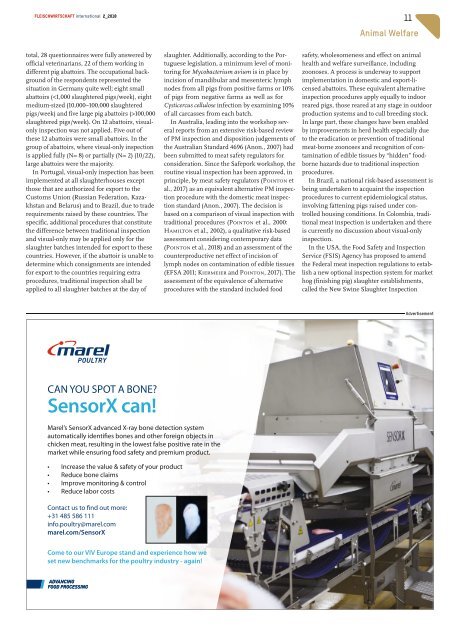FLEISCHWIRTSCHAFT international 2/2018
Create successful ePaper yourself
Turn your PDF publications into a flip-book with our unique Google optimized e-Paper software.
Fleischwirtschaft <strong>international</strong> 2_<strong>2018</strong><br />
11<br />
Animal Welfare<br />
total, 28 questionnaires were fully answered by<br />
official veterinarians, 22 of them working in<br />
different pig abattoirs. The occupational background<br />
of the respondents represented the<br />
situation in Germany quite well; eight small<br />
abattoirs (100,000<br />
slaughtered pigs/week). On 12 abattoirs, visualonly<br />
inspection was not applied. Five out of<br />
these 12 abattoirs were small abattoirs. In the<br />
group of abattoirs, where visualonly inspection<br />
is applied fully (N= 8) or partially (N= 2) (10/22),<br />
large abattoirs were the majority.<br />
In Portugal, visualonly inspection has been<br />
implemented at all slaughterhouses except<br />
those that are authorized for export to the<br />
Customs Union (Russian Federation, Kazakhstan<br />
and Belarus) and to Brazil, due to trade<br />
requirements raised by these countries. The<br />
specific, additional procedures that constitute<br />
the difference between traditional inspection<br />
and visualonly may be applied only for the<br />
slaughter batches intended for export to these<br />
countries. However,ifthe abattoir is unable to<br />
determine which consignments are intended<br />
for export to the countries requiring extra<br />
procedures, traditional inspection shall be<br />
applied to all slaughter batches at the day of<br />
slaughter.Additionally,according to the Portuguese<br />
legislation, aminimum level of monitoring<br />
for Mycobacterium avium is in place by<br />
incision of mandibular and mesenteric lymph<br />
nodes from all pigs from positive farms or 10%<br />
of pigs from negative farms as well as for<br />
Cysticercus cellulose infection by examining 10%<br />
of all carcasses from each batch.<br />
In Australia, leading into the workshop several<br />
reports from an extensive riskbased review<br />
of PM inspection and disposition judgements of<br />
the Australian Standard 4696 (Anon., 2007) had<br />
been submitted to meat safety regulators for<br />
consideration. Since the Safepork workshop, the<br />
routine visual inspection has been approved, in<br />
principle, by meat safety regulators (POINTON et<br />
al., 2017)asan equivalent alternative PM inspection<br />
procedure with the domestic meat inspection<br />
standard (Anon., 2007). The decision is<br />
based on acomparison of visual inspection with<br />
traditional procedures (POINTON et al., 2000:<br />
HAMILTON et al., 2002), aqualitative riskbased<br />
assessment considering contemporary data<br />
(POINTON et al., <strong>2018</strong>)and an assessment of the<br />
counterproductive net effect of incision of<br />
lymph nodes on contamination of edible tissues<br />
(EFSA 2011;KIERMEIER and POINTON,2017). The<br />
assessment of the equivalence of alternative<br />
procedures with the standard included food<br />
safety,wholesomeness and effect on animal<br />
health and welfare surveillance, including<br />
zoonoses. Aprocess is underway to support<br />
implementation in domestic and exportlicensed<br />
abattoirs. These equivalent alternative<br />
inspection procedures apply equally to indoor<br />
reared pigs, those reared at any stage in outdoor<br />
production systems and to cull breeding stock.<br />
In large part, these changes have been enabled<br />
by improvements in herd health especially due<br />
to the eradication or prevention of traditional<br />
meatborne zoonoses and recognition of contamination<br />
of edible tissues by “hidden” foodborne<br />
hazards due to traditional inspection<br />
procedures.<br />
In Brazil, anational riskbased assessment is<br />
being undertaken to acquaint the inspection<br />
procedures to current epidemiological status,<br />
involving fattening pigs raised under controlled<br />
housing conditions. In Colombia, traditional<br />
meat inspection is undertaken and there<br />
is currently no discussion about visualonly<br />
inspection.<br />
In the USA, the Food Safety and Inspection<br />
Service (FSIS) Agency has proposed to amend<br />
the Federal meat inspection regulations to establish<br />
anew optional inspection system for market<br />
hog (finishing pig) slaughter establishments,<br />
called the NewSwine Slaughter Inspection<br />
Advertisement

















